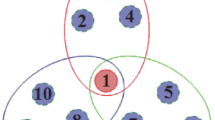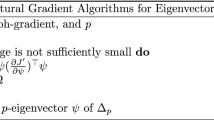Abstract
In this paper, we propose a constraint preserving algorithm for the smallest Z-eigenpair of the compact Laplacian tensor of an even-uniform hypergraph, where Householder transform is employed and a family of modified conjugate directions with sufficient descent is determined. Besides, we prove that there exists a positive step size in the new constraint preserving update scheme such that the Wolfe conditions hold. Based on these properties, we prove the convergence of the new algorithm. Furthermore, we apply our algorithm to the hypergraph partitioning and image segmentation, and numerical results are reported to illustrate the efficiency of the proposed algorithm.







Similar content being viewed by others
Availability of supporting data
The authors confirm that all data generated or analyzed during this study are included in this paper.
References
Abdollahi, F., Fatemi, M.: A modified conjugate gradient method for general convex functions. Numer Algor. 92, 1485–1502 (2023)
Bu, C., Fan, Y., Zhou, J.: Laplacian and signless Laplacian Z-eigenvalues of uniform hypergraphs. Front. Math. China. 11, 511–520 (2016)
Bulò, S.R., Pelillo, M.: New bounds on the clique number of graphs based on spectral hypergraph theory. In: Stützle, T. (ed.) Learning and intelligent optimization, pp. 45–48. Springer Verlag, Berlin (2009)
Chang, J., Chen, Y., Qi, L.: Computing eigenvalues of large scale sparse tensors arising from a hypergraph. SIAM J. Sci. Comput. 38(6), A3618–A3643 (2016)
Chang, J., Ding, W., Qi, L., Yan, H.: Computing the \(p\)-spectral radii of uniform hypergraphs with applications. J. Sci. Comput. 75, 1–25 (2018)
Chang, J., Qi, L., Yan, H.: Hypergraph clustering using a new Laplacian tensor with applications in image processing. SIAM J. Imaging. Sci. 13(3), 1157–1178 (2020)
Chen, L., Han, L., Zhou, L.: Computing tensor eigenvalues via homotopy methods. SIAM J. Matrix Anal. Appl. 37, 290–319 (2016)
Chen, Y., Qi, L., Wang, Q.: Computing extreme eigenvalues of large scale Hankel tensors. J. Sci. Comput. 68, 716–738 (2016)
Chen, Y., Qi, L., Zhang, X.: The Fiedler vector of a Laplacian tensor for hypergraph partitioning. SIAM J. Sci. Comput. 39(6), A2508–A2537 (2017)
Chen, Z., Qi, L.: Circulant tensors with applications to spectral hypergraph theory and stochastic process. J. Ind. Manag. Optim. 12, 1227–1247 (2016)
Chung, F.: Spectral graph theory. AMS, Providence RI (1997)
Chung, F., Lu, L.: Complex graphs and networks. AMS, Providence, RI (2006)
Cooper, J., Dutle, A.: Spectra of uniform hypergraphs. Linear Algebra Appl. 436(9), 3268–3292 (2012)
Cui, C., Dai, Y., Nie, J.: All real eigenvalues of symmetric tensors. SIAM J. Matrix Anal. Appl. 35, 1582–1601 (2014)
Dai, Y.: New properties of a nonlinear conjugate gradient method. Numer. Math. 89, 83–98 (2001)
Dai, Y., Yuan, Y.: A nonlinear conjugate gradient method with a strong global convergence property. SIAM J. Optim. 10(1), 177–182 (1999)
Dai, Y., Yuan, Y.: Nonlinear conjugate gradient methods. Shanghai Science and Technology Press, Shanghai (2000)
De Lathauwer, L., De Moor, B., Vandewalle, J.: On the best rank-1 and rank-(\(R_1, R_2, \dots, R_N\)) approximation of higher-order tensors. SIAM J. Matrix Anal. Appl. 21, 1324–1342 (2000)
Dorai, C., Jain, A.K.: Shape spectra based view grouping for free-form objects. In Proceedings of the International Conference on Image Processing, IEEE 3, 340–343 (1995)
Fan, Y., Khan, M.I., Tan, Y.: The largest H-eigenvalue and spectral radius of Laplacian tensor of non-odd-bipartite generalized power hypergraphs. Linear Algebra Appl. 504, 487–502 (2016)
Fiedler, M.: Algebraic connectivity of graphs. Czechoslovak Math. J. 23, 298–305 (1973)
Fiedler, M.: A property of eigenvectors of nonnegative symmetric matrices and its application to graph theory. Czechoslovak Math. J. 25, 619–633 (1973)
Fletcher, R.: Practical methods of optimization vol. 1: Unconstrained Optimization. John Wiley & Sons, New York (1987)
Fletcher, R., Reeves, C.: Function minimization by conjugate gradients. Comput. J. 7, 149–154 (1964)
Ghoshdastidar, D., Dukkipati, A.: A provable generalized tensor spectral method for uniform hypergraph partitioning. In Proceedings of the International Conference on Machine Learning 400–409 (2015)
Gilbert, J.C., Nocedal, J.: Global convergence properties of conjugate gradient methods for optimization. SIAM J. Optim. 2, 21–42 (1992)
Govindu, V.M., Van Loan, C.F.: A tensor decomposition for geometric grouping and segmentation. In Proceedings of the IEEE Computer Society Conference on Computer Vision and Pattern Recognition (CVPR’05) 1, 1150–1157 (2005)
Hager, W.W., Zhang, H.: A new conjugate gradient method with guaranteed descent and an efficient line search. SIAM J. Optim. 16, 170–192 (2005)
Hager, W.W., Zhang, H.: A survey of nonlinear conjugate gradient methods. Pac. J. Optim. 2(1), 35–58 (2006)
Han, J., Pei, J., Kamber, M.: Data mining: concepts and techniques. Elsevier, New York (2011)
Hao, C., Cui, C., Dai, Y.: A sequential subspace projection method for extreme Z-eigenvalues of supersymmetric tensors. Numer. Linear Algebra Appl. 22, 283–298 (2015)
Hestenes, M.R., Stiefel, E.L.: Methods of conjugate gradients for solving linear systems. J. Res. Nat. Bur. Standards Sect. 5(49), 409–436 (1952)
Hinneburg, A., Keim, D.A.: An efficient approach to clustering in large multimedia databases with noise. In Proceedings of KDD 58–65 (1998)
Hu, S., Qi, L.: Algebraic connectivity of an even uniform hypergraph. J. Comb. Optim. 24, 564–579 (2012)
Hu, S., Qi, L.: The Laplacian of a uniform hypergraph. J. Comb. Optim. 29(2), 331–366 (2015)
Huang, Z.: A fast clustering algorithm to cluster very large categorical data sets in data mining. Data Min. Knowl. Discov. 3, 34–39 (1997)
Jiang, D., Wu, S., Chen, G., Ooi, B.C., Tan, K.-L., Xu, J.: epiC: an extensible and scalable system for processing Big Data. VLDB J. 25, 3–26 (2016)
Jain, A.K., Murty, M.N., Flynn, P.J.: Data clustering: a review. ACM Comput. Surv. 31, 264–323 (1999)
Kang, S.H., Shafei, B., Steidl, G.: Supervised and transductive multi-class segmentation using \(p\)-Laplacians and RKHS methods. J. Vis. Commun. Image Represent. 25(5), 1136–1148 (2014)
Klamt, S., Haus, U.-U., Theis, F.: Hypergraphs and cellular networks. PLoS Comput. Biol. 5(5), e1000385 (2009)
Kofidis, E., Regalia, P.A.: On the best rank-1 approximation of higher-order supersymmetric tensors. SIAM J. Matrix Anal. Appl. 23(3), 863–884 (2002)
Kolda, T.G., Mayo, J.R.: Shifted power method for computing tensor eigenpairs. SIAM J. Matrix Anal. Appl. 32(4), 1095–1124 (2011)
Kolda, T.G., Mayo, J.R.: An adaptive shifted power method for computing generalized tensor eigenpairs. SIAM J. Matrix Anal. Appl. 35(4), 1563–1581 (2014)
Li, G., Qi, L., Yu, G.: The Z-eigenvalues of a symmetric tensor and its application to spectral hypergraph theory. Numer. Linear Algebra Appl. 20(6), 1001–1029 (2013)
Lim, L.H.: Singular values and eigenvalues of tensors: a variational approach. In Proceedings of the IEEE International Workshop on Computational Advances in Multi-Sensor Adaptive Processing (CAMSAP’05) 1, 129–132 (2005)
Liu, L., Storey, C.: Efficient generalized conjugate gradient algorithms, Part 1: Theory. J. Optim. Theory Appl. 69, 129–137 (1991)
Ni, Q.: Optimization methods and programming. Science Press, Beijing (2009)
Ni, Q., Qi, L.: A quadratically convergent algorithm for finding the largest eigenvalue of a nonnegative homogeneous polynomial map. J. Glob. Optim. 61, 627–641 (2015)
Polak, E., Ribière, G.: Note sur la convergence de directions conjugées. Rev. Francaise Informat. Recherche Opertionelle, 3e Année 16, 35–43 (1969)
Polyak, B.T.: The conjugate gradient method in extreme problems. USSR Comp. Math. Math. Phys. 9, 94–112 (1969)
Qi, L.: Eigenvalues of a real supersymmetric tensor. J. Symb. Comput. 40(6), 1302–1324 (2005)
Qi, L.: H\(^+\)-eigenvalues of Laplacian and signless Lapaclian tensors. Comm. Math. Sci. 12(6), 1045–1064 (2014)
Saxena, A., Prasad, M., Gupta, A., Bharill, N., Patel, O.P., Tiwari, A., Er, M.J., Ding, W., Lin, C.-T.: A review of clustering techniques and developments. Neurocomputing 267, 664–681 (2017)
Xie, J., Chang, A.: A new type of Laplacian tensor and its Z-eigenvalues of an even uniform hypergraph. Int. J. Appl. Math. Stat. 31, 9–19 (2013)
Xie, J., Qi, L.: The clique and coclique numbers’ bounds based on the H-eigenvalues of uniform hypergraphs. Int. J. Numer. Anal, Mod. 12(2), 318–327 (2015)
Xie, J., Qi, L.: Spectral directed hypergraph theory via tensors. Linear Multilinear Algebra 64, 780–794 (2016)
Yu, G., Yu, Z., Xu, Y., et al.: An adaptive gradient method for computing generalized tensor eigenpairs. Comput. Optim. Appl. 65, 781–797 (2016)
Yuan, G., Meng, Z., Li, Y.: A modified Hestenes and Stiefel conjugate gradient algorithm for large-scale nonsmooth minimizations and nonlinear equations. J. Optim. Theory. Appl. 168, 129–152 (2016)
Yuan, G., Wei, Z., Yang, Y.: The global convergence of the Polak-Ribière-Polyak conjugate gradient algorithm under inexact line search for nonconvex functions. J. Comput. Appl. Math. 362, 262–275 (2019)
Yuan, G., Wang, X., Sheng, Z.: Family weak conjugate gradient algorithms and their convergence analysis for nonconvex functions. Numer Algor. 84, 935–956 (2020)
Yuan, Y., Sun, W.: Optimization theory and methods. Science Press, Beijing (1999)
Zhang, X., Ni, Q., Ge, Z.: A convergent Newton algorithm for computing Z-eigenvalues of an almost nonnegative irreducible tensor. Optim. Method. Softw. 35(2), 377–393 (2020)
Acknowledgements
The authors would like to thank Dr. Yannan Chen for his insightful discussions on hypergraph partitioning and image segmentation.
Funding
This paper was supported by Suqian Sci & Tech Program (Grant No. Z2020135 and K202112), the National Natural Science Foundation of China (Grant No. 11901118, 12001281 and 62073087), the Anhui Provincial Natural Science Foundation (Grant No. 2208085QA07), and the Youth Foundation of Anhui University of Technology (Grant No. QZ202114) and was sponsored by Qing Lan Project.
Author information
Authors and Affiliations
Contributions
The first author prepared the mathematica programs of the presented algorithms, all authors wrote the main manuscript text and prepared the tables and figures, and all authors reviewed the manuscript.
Corresponding author
Ethics declarations
Ethics approval and consent to participate
Not applicable
Conflict of interest
The authors declare no competing interests.
Additional information
Publisher's Note
Springer Nature remains neutral with regard to jurisdictional claims in published maps and institutional affiliations.
Rights and permissions
Springer Nature or its licensor (e.g. a society or other partner) holds exclusive rights to this article under a publishing agreement with the author(s) or other rightsholder(s); author self-archiving of the accepted manuscript version of this article is solely governed by the terms of such publishing agreement and applicable law.
About this article
Cite this article
Zhang, X., Chang, J., Ge, Z. et al. A family of gradient methods using Householder transformation with application to hypergraph partitioning. Numer Algor 95, 897–927 (2024). https://doi.org/10.1007/s11075-023-01593-y
Received:
Accepted:
Published:
Issue Date:
DOI: https://doi.org/10.1007/s11075-023-01593-y




